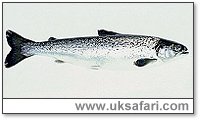
|

|
|
 Sent
to you Sent
to you
by e-mail
|
|
Simply
enter your details and hit the send button
more
info |
|


Click Here

Links
Advertise
Terms of Use
Contributors
About Us
Contact Us
|
 |
Go back
 | Bookmark
| Bookmark
 | Print Page
| Print Page  | E-Mail Us
| E-Mail Us 
 

Photo: Ian Wilkinson
|
|
Latin name: Salmo salar
Size: Grows to 130cms long. A fully grown male can weigh over 35kgs.
Distribution: Throughout the UK, especially in Scotland.
Months seen: All year round.
Food: In freshwater ther feed on invertebrates such as mayflies, caddis flies and their larvae. Out at sea they feed on fish
Habitat: Clean, well oxygenated rivers.
Special features: The back of the adult salmon is blue-black and the sides are silver with a blue or pink tint. The fins are dark grey. The belly is silvery white with a pink tint. At spawning time the belly becomes more red. Also at spawning time the male develops a hook shaped lower jaw.
Adult salmon spend the majority of the year in the Atlantic Ocean. In September and October the adult salmon get the urge to return to their spawning grounds. This upstream journey can involve spectacular leaps of over 3 metres up waterfalls and rapids.
By early November spawning starts and this may continue until mid-December. The eggs are laid in a saucer shaped depression in the gravel river bed called a 'redd'.
 As soon as the female lays the eggs, the male fish moves in to fertilise them. Finally the female covers them over.
As soon as the female lays the eggs, the male fish moves in to fertilise them. Finally the female covers them over.
 By late March the young salmon, called 'alevins', hatch out. They still have a yolk sac suspended from their stomachs, but this disappears after a few weeks. By late March the young salmon, called 'alevins', hatch out. They still have a yolk sac suspended from their stomachs, but this disappears after a few weeks.
For the first year of their lives the young fish are called 'fry'. Only about 5 per cent will survive to the adult stage.
 A one to three year old fish is known as a 'parr'. They have a distinctive fingerprint marking along their sides separated by small red dots. A one to three year old fish is known as a 'parr'. They have a distinctive fingerprint marking along their sides separated by small red dots.
At this stage the fish are already sexually mature, and able to fertilise the females eggs.
 Finally the fish lose their parr markings and develop a silvery coat to their scales. Now known as 'smolts', they are still only about 10cms long. Finally the fish lose their parr markings and develop a silvery coat to their scales. Now known as 'smolts', they are still only about 10cms long.
Eventually the fins darken, and they now look like miniature adult salmon. At this stage they are ready to make their way downstream to saltwater estuaries and on to the Atlantic Ocean.
|

UK Safari Freshwater Wildlife Section
|
 |

|